Popcorn Ceilings’ Hidden Dangers and How They Affect Home Values
Do you want to know if a popcorn ceiling reduces the value of your home? The answer is, of course, yes. While this design trend was popular in the past, it is no longer appealing to homeowners today. A popcorn ceiling, in fact, can make your home appear outdated and unappealing to potential buyers. Furthermore, these ceilings are known to collect dust and debris over time, posing health risks, particularly for those with allergies or respiratory issues. As a result, removing the popcorn ceiling will almost always increase the value of your home and attract more buyers who want a modern and safe living space.
If you plan to sell your home, you should consider removing the popcorn ceiling first. It’s a simple and inexpensive project that could increase the value of your home and help you get top dollar.
What exactly are Popcorn Ceilings?
Popcorn ceilings were once a popular home design feature, but they are now widely regarded as an eyesore. These textured ceilings are created by covering the ceiling with a stucco-like material and then spraying it with a popcorn-like substance. As a result, the surface becomes textured and bumpy, making it difficult to clean and repair.
Popcorn ceilings can be hazardous as well. The surface’s small bumps can collect dust and other allergens, causing respiratory problems in some people. Furthermore, the materials used to make popcorn ceilings may contain asbestos, which is dangerous if inhaled.
If you plan to sell your home, you should be aware that many buyers will not consider homes with popcorn ceilings. This is due to the fact that they are difficult to repair and may pose health risks. As a result, having popcorn ceilings may reduce the value of your home.
Popcorn Ceilings’ Unknown Dangers
Popcorn ceilings were a popular design element in 1970s and 1980s homes. However, many homeowners are unaware that these textured ceilings can be hazardous. Here are some of the unintended consequences of popcorn ceilings:
1. Asbestos: Asbestos, a known carcinogen, is found in many popcorn ceilings. If your house was built before 1978, your popcorn ceiling most likely contains asbestos. If you intend to remove the popcorn ceiling yourself, take proper safety precautions to avoid asbestos fibre exposure.
2. Mould: Mould can grow on popcorn ceilings as well. Mould spores thrive in this environment because of the textured surface. Mould can also cause respiratory problems and other health problems when it grows on your ceiling.
3. Fire Hazard: Popcorn ceilings can catch fire. The texture of the popcorn can act as fuel for a fire, and it is also difficult to put out a fire that begins on a popcorn ceiling.
4. Allergies: Some people are allergic to the materials used in popcorn ceilings, which can result in respiratory issues and other health problems.
If you have a popcorn ceiling in your home, you should be aware of the risks it poses. Consider removing the popcorn ceiling or taking other precautions to reduce the risks associated with it.
The Effect on Home Values
If you plan to sell your home, you should consider removing any popcorn ceilings first. Popcorn ceilings can actually reduce the value of your home because they are perceived as dated and difficult to maintain. Not only that, but popcorn ceilings can pose a health risk due to the presence of asbestos fibres. If your home has a popcorn ceiling, it is best to have it professionally removed by a certified contractor.


